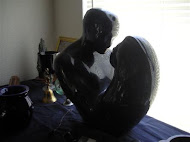* A Ritual for Two *
Adapted from J. Broch and Veronica MacLer's
Seasonal Dance
Preparation: Decorate the Circle with buds of flowers, if available. All element candles and other candles around the circle should be white. Ring the Circle with small white candles. Place the cauldron and three large white candles on the altar, ringed with new greenery. Each person should have a small, unlit white taper (3 inch) and a slip of paper with the words to the songs as he or she enters the circle. Because this is the festival when the ewes begin producing milk for the newborn lambs, use milk or a beverage like Irish Crème Liquor in the chalice.
The Ritual: Priestess invokes the elements. She moves deosil to the North (Earth) quarter and says:
"Spirits of the empty fields, waiting silently
under a blanket of snow, join us in greeting our lady bright."
The Priestess then moves to the East (Air) quarter and says:
"Spirits of the warming winds, blowing ever
stronger from the south, join us in greeting our lady bright."
The Priestess then moves to the South (Fire) quarter and says:
"Spirits of the shining flame, burning in the
infant Sun, join us in greeting our lady bright."
The Priestess moves to the West (Water) quarter and says:
"Spirits of the forest streams, breaking free
from your prison of ice, join us in greeting our lady bright."
Priestess returns to the altar and lights the first altar candle,, and says:
"Bridgit, lady of fire, of hearth and forge,
we welcome your return."
Priestess lights the second altar candle and says:
"Bride, lady of healing, of peace and joy,
we welcome your return."
Priestess lights the third altar candle and says:
"Bri'id, lady of inspiration, of vision and poetry,
we welcome your return."
Priestess raises hands in invocation and says:
"Bri'id returns from her winter sleep,
Warm Spring follows in her steps.
Soon the trees are green again,
Soon the flowers bloom.
We welcome back our Lady Bri'id
And every house makes room."
Companion says:
"Bri'id is come! Bri'id is welcome!"
The Priestess says:
"She lays aside her cloak of death
And wakes the world with her sweet breath."
Companion says:
"Bri'id is come! Bri'id is welcome!"
The Priestess says:
"And in the dark and frozen lands
We joyfully greet the newborn lambs."
Companion says:
"Bri'id is come! Bri'id is welcome!"
The Priestess says:
"And grateful for this sign of life
We gather here by candlelight."
Companion says:
"Bri'id is come! Bri'id is welcome!"
The Priestess says:
"And in the depths of winter's blight
We welcome Bri'id, our Lady Bright."
Companion says:
"Bri'id is come! Bri'id is welcome!"
The Priestess says:
"And all her bards will form a ring
And to their Lady Bri'id they sing:"
Companion says:
"Bri'id is come! Bri'id is welcome!"
The Priestess takes her candle and lights it from the first alter candle. She says:
"Fire of Bridgit, keep us warm through the
year and fill our home with love."
The Priestess holds her candle in the flame of the second altar candle. She says:
"Fire of Bride, burn away our illnesses
and fill our hearts with joy."
The Priestess holds her candle in the flame of the third altar candle. She says:
"Fire of Bri'id, shine as our guide
and fill our souls with song."
The Priestess turns to her companion in the circle and lights their candle from her own. She says:
"Bridgit of shining fire,
Lady of flickering flame,
Grant us our heart's desire,
Be with us, we call your name!"
The Priestess' companion hold her/his candle to hers. The companion says:
"Bridgit of shining fire,
Lady of flickering flame,
Grant us our heart's desire,
Be with us, we call your name!"
The companion then lights the candles around the circle, deosil while saying:
"Bri'id is come! Bri'id is welcome!"
When the companion returns to the alter the Priestess and her companion place their candles upon the altar. Together they repeat aloud the following:
"Bridgit of shining fire,
Grant us our heart's desire,
Be with us, we call your name!"
The Priestess takes up the chalice holding it skyward and says:
"Bridgit, Bride, Bri'id,
We welcome you into our home and our hearts.
Shine brightly for us, Lady of Fire,
That we may always feel your warmth."
The Priestess drinks from the chalice while her companion says:
"Bridgit of shining fire,
Lady of flickering flame,
Grant us our heart's desire,
Be with us, we call your name!"
The Priestess passes the chalice to her companion who drinks from it while the Priestess says:
"Bridgit of shining fire,
Lady of flickering flame,
Grant us our heart's desire,
Be with us, we call your name!"
Replace the chalice on the altar. The Priestess thanks the elements (moving widdershins beginning with the West) and says:
"Rejoice, oh spirits of the Stream:
Bri'id is come! You soon flow free!
Spirits of the infant Sun,
Rejoice! Your Lady Bri'id is come!
Spirits of the warming Air,
Rejoice! Your Lady Bri'id is here!
Rejoice oh spirits of the Earth!
Bri'id is here! You soon give birth!"
The Priestess returns to the altar and raises hands in benediction. She says:
"Lady Bri'id, we welcome you into the world once again!
Our Circle is open. Let the feasting begin!"
The companion lifts hands skyward and says:
"Bri'id is come! Bri'id is welcome!"
The Priestess and companion now partake of the feast, thus completing the ritual.
Blessed be!
Disclaimer: No one involved in this blog or its contents may be held responsible for any adverse reactions arising from following any of the instructions / recipes on this list. It is the reader's personal responsibility to exercise all precautions and use his or her own discretion if following any instructions or advice from this blog.
















